
Rivers & Creeks
Looking for some moving water? The topography of the Blue Ridge Mountains has helped form the best fishing, kayaking, and canoeing rivers in Virginia. Try playing on the rivers and creeks throughout the Roanoke Region.
Some of the more well-known bodies of water include the Roanoke River, Pigg River, and James River. Popular creeks for whitewater include Bottom Creek, Bullpasture River, and Potts Creek, depending on water levels.
Find Rivers & Creeks
Rivers
-
Bullpasture River
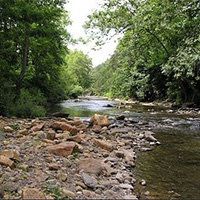 Bullpasture River is classic Class III+ rapids located in Alleghany Highlands. The river feeds into the Cowpasture River. Paddling from the public access (Route 678) to the Cowpasture River at Bullpasture Gorge is 4 miles.
Bullpasture River is classic Class III+ rapids located in Alleghany Highlands. The river feeds into the Cowpasture River. Paddling from the public access (Route 678) to the Cowpasture River at Bullpasture Gorge is 4 miles.The gorge is a fun section and is good for intermediates or someone who just enjoys Class III fun in a scenic gorge. The rapids become more difficult the further into the gorge, so it gives those who are stepping up to Class III a chance to warm up.
-
Cowpasture River
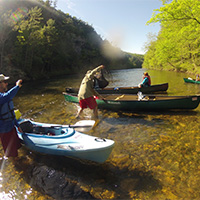 The Cowpasture River flows through some of western Virginia’s most scenic, rural landscapes. Beginning in Highland County, it flows south through Bath, Alleghany, and Botetourt counties for more than 80 miles. At Iron Gate, it joins the Jackson River to form the James River.
The Cowpasture River flows through some of western Virginia’s most scenic, rural landscapes. Beginning in Highland County, it flows south through Bath, Alleghany, and Botetourt counties for more than 80 miles. At Iron Gate, it joins the Jackson River to form the James River.Find flow information for the Cowpasture River:
- McKinney Hollow (Clifton Forge)
- Williamsville (Bath County)
-
Jackson River
The Jackson River contributes a distinct and scenic landscape feature, while providing a natural habitat for reproducing wild trout. The Jackson River starts at Lake Moomaw, where water is released from the Gathright Dam, and flows 43.5 miles to where it merges with the Cowpasture River and forms the James River. The Jackson is an excellent smallmouth bass, rock bass, rainbow trout, and brown trout fishery.
Note: their is a mandatory takeout on the Jackson River between miles 24-26.
The Jackson River Scenic Trail is a cinder rail trail that parallels the Jackson River for about 16 miles.
-
James River
 The James River is a popular river for boating, canoeing, and kayaking. The largest drainage river in Virginia offers Class I to Class III+ rapids.
The James River is a popular river for boating, canoeing, and kayaking. The largest drainage river in Virginia offers Class I to Class III+ rapids.The James River begins its journey in Botetourt County, winding through the Allegheny and Blue Ridge Mountains on its way to the Chesapeake Bay. The unspoiled beauty of the river is more accessible than ever through the Upper James River Water Trail. Paddlers, anglers and families can get back to nature and enjoy the sights and sounds of 45 miles of the Upper James, including 14 pristine miles designated as a Virginia Scenic River.
-
Little River
-
Maury River
The Maury River provides 37 miles of paddling and fishing fun. This Class II-IV river is best run April through June and with higher water levels.
- The Rockbridge Baths section includes Class II-III rapids
- The Goshen Pass includes Class II-III, with one Class IV that is easily portaged (Devils Kitchen)
-
New River
The New River is a great fishing, tubing, canoeing, and kayaking spot featuring Class I to Class III+ water. The New River is the second oldest river in the world, giving anglers and paddlers world-class excitement, and is one of the few rivers that flows north. It is ideal for kayaking, canoeing, tubing, and fishing.
There are multiple outfitters serving the New River to help you plan your trip or provide a place to park or grab gear.
-
Pigg River Blueway
The Pigg River Blueway makes for a relaxing float in Franklin County. This Class I water is great for a nice fishing float or a leisure canoe trip with the family.
Starting at the 500 acre Waid Recreation Area, this eight mile float takes you through the rolling countryside south of Franklin County. The float takes about four to five hours to complete, making it the perfect weekend activity. The take-out is in Lynch Park, a 3-mile shuttle for your vehicle.
You will want to check water levels before attempting this float. Generally speaking, if the Blackwater gauge shows 2.3 feet, the river will be at the perfect level.
-
Roanoke River
The Roanoke River offers a unique combination of urban, front country, and back country recreation opportunities in the upper Roanoke River watershed. Enjoy canoeing, kayaking, fishing, tubing, wading, wildlife viewing, and watershed education with convenient access to other outdoor and cultural amenities.
-
Smith River
Smith River has strong and challenging waters (Class II), especially when water is released from the Philpott Dam. It is perhaps the best option for play waves in southern Virginia during the late summer.
There are almost 12 miles to float. Put-in at the base of Philpott Dam and take-outs placed about every 6 miles downstream.
This is a quite scenic route as well. Check out the fog that forms on warm, humid days as the cold water reacts with the air. There are times when you can’t see 30 feet in front of your boat. It makes a totally unique paddling experience in Virginia.
-
Upper Blackwater River Blueway
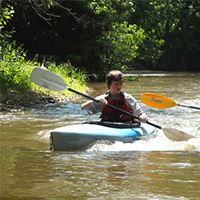 The Upper Blackwater River Blueway is a 35-mile section with many paddling possibilities. Located about 25 minutes from Downtown Roanoke, this delightful float takes you through the foothills in Franklin County.
The Upper Blackwater River Blueway is a 35-mile section with many paddling possibilities. Located about 25 minutes from Downtown Roanoke, this delightful float takes you through the foothills in Franklin County.Starting in the headwaters of Cahas Mountain, the Blackwater River continues until it terminates in the backwaters of Smith Mountain Lake. The float is a water dependent run so pay attention to gauges. Generally speaking, you need at least 2.3 feet on the Blackwater gauge to make the run enjoyable. Don’t miss the section from U.S. 220 to the Farm View Road ford as this section has a series of low Class II water that is a blast for beginners.
Creeks
-
Barbours Creek
-
Bottom Creek
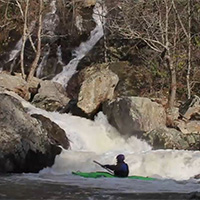 Bottom Creek is a solid Class V+ steep creek with mandatory portages. It is highly recommended that your first run be with someone who knows the river well.
Bottom Creek is a solid Class V+ steep creek with mandatory portages. It is highly recommended that your first run be with someone who knows the river well.There are usually at least two or three carries, but there is always at least one mandatory portage in there – you must get out at the right spot above “Eye Of The Needle” (aka, “Inner Earth”). It is easy to miss this exit point and drop past the point-of-no-return. Most boaters, at most flows, carry “Gravity Cavity” and “Gorilla North” as well.
-
Catawba Creek
-
Craig Creek
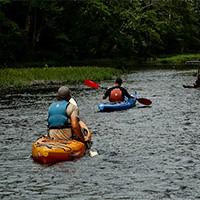 Craig Creek is popular for kayaking, rafting, and paddling in Class I-II waters.
Craig Creek is popular for kayaking, rafting, and paddling in Class I-II waters.The float is along an incredibly beautiful shallow creek that meanders its way through lush vegetation. It is best paddled in the fall or spring, or after a significant rainfall. There are several sections to float between New Castle and Eagle Rock.
Wilderness Adventure at Eagle Landing an outfitter located along Craig Creek, can provide water level updates, canoe, kayak, or tube rentals, camping and cabin rentals, and even provide shuttle service.
-
Dunlap Creek
-
Jennings Creek
-
Little Stony Creek
Little Stony Creek begins at the Cascade Falls trailhead and feeds into the New River. It features Class IV-V waters and is 1.6 miles. This stocked trout stream becomes a Class V+ creek at high water.
-
Little Walker Creek
Little Walker Creek is a scenic Class I-III float near the New River. The 7.5 mile stretch runs from Alum Springs (Route 643) to Big Walker Creek (Route 100).
-
North Creek
North Creek is a great fishing stream and at higher levels features a Class II-IV creek run. The 2.5 mile stretch runs from the campground to Jennings Creek.
-
Potts Creek
Potts Creek offers tremendous fishing at low water levels and at higher levels it provides great Class II-IV whitewater. One of the most popular sections of the 32.5-mile section between Pint Bank and the Jackson River is to start near the campground near Paint Bank, a section with Class II-III rapids.
-
Roaring Run
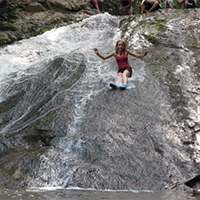 Roaring Run is an excellent hiking trail for the whole family. The easy, well-marked trail begins at a historic iron furnace and winds back and forth along the Roaring Run stream. You will pass rock walls, cascading water, and cross five footbridges before ending at beautiful Roaring Run Falls.
Roaring Run is an excellent hiking trail for the whole family. The easy, well-marked trail begins at a historic iron furnace and winds back and forth along the Roaring Run stream. You will pass rock walls, cascading water, and cross five footbridges before ending at beautiful Roaring Run Falls.It is also a great trout stream with a natural water slide at lower levels. At higher levels, it becomes a Class V+ creek.
- Easy (out and back hike)
- Approximately halfway to the falls is a natural water slide
- Toilets and picnic area with charcoal grill
-
Stony Creek
Stony Creek is a stocked trout stream that feeds into the New River near Pearisburg. At high water levels, it is a classic Class III-V creek that spans 7 miles from the Jefferson National Forest (Route 635) to Big Sony Creek.
-
Walker Creek
Walker Creek feeds into the New River in Pearisburg. It is a Class I-II whitewater run, when water levels are at their best. The Walker Creek section extends 29.5 miles from White Gate (Route 713) along the New River (Route 636) to Big Walker Creek.
-
Wilson Creek
Wilson Creek is a Class II-III section of whitewater that begins inside Douthat State Park. The 7.5-mile section of creek flows from the Douthat Lake dam to the Jackson River.

Create Your Own Water Adventure
Get Started
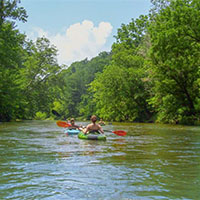
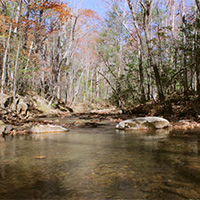
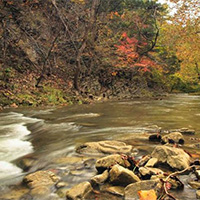
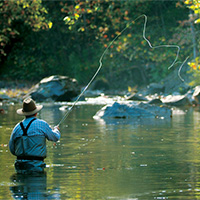
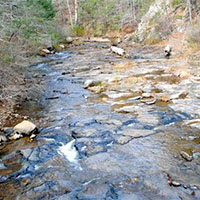
 Powered by Roanoke Outside
Powered by Roanoke Outside